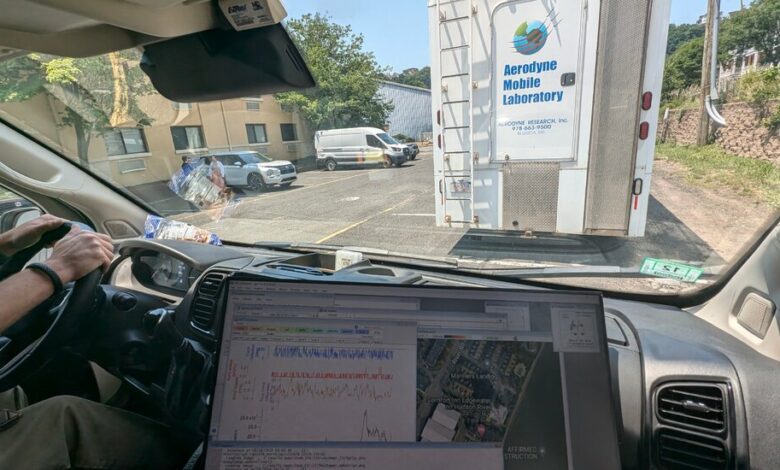A ride in a chemical-sniffing van shows how heat increases pollution

Two vans loaded with precision instruments drove through the streets of New York and New Jersey in the heat earlier this week, searching for toxic chemicals in the air.
They found spikes in methane, a potent greenhouse gas, most likely from leaks or from natural gas-burning buses. They found plumes of laughing gas, possibly from wastewater. And throughout the ride, they recorded elevated levels of ozone, the key ingredient of smog, and of the carcinogenic formaldehyde – both of which form easily in hot weather.
The bottom line: the streets are littered with pollution hotspots. And the heat makes the pollution worse.
“If you want a chemical reaction to happen faster, you add heat,” said Peter DeCarlo, an atmospheric air pollution researcher at Johns Hopkins University who is leading an effort to use the vans to reduce emissions along the Louisiana Petrochemical Corridor. “On warmer days it’s the same idea,” he said.
Air pollution increases as temperatures rise, increasing the damage caused by global warming. It’s one reason why cities and counties in the eastern United States hit by a heat wave this week have issued air pollution warnings.
For the past three days, New York City has warned that ozone in the city is at levels that are “unhealthy for sensitive groups.” Detroit and Chicago also issued air quality warnings this week. Drivers in Ohio, Michigan, Kentucky and Indiana have been urged not to fill up their cars before 8 p.m. and to carpool or not drive as much as possible to reduce exhaust emissions.
The bad air has to do with atmospheric chemistry, Prof. DeCarlo said, as his van navigated through the South Bronx, East Harlem and Midtown with two New York Times journalists along for the ride. Pollution from the combustion of fossil fuels reacts with heat and sunlight, creating ground-level ozone. Higher temperatures turbocharge that process.
Formaldehyde emissions, which can come from sources as diverse as wildfires and household products, also increase with higher temperatures. “The same chemistry that generates high ozone levels also produces additional dangerous air pollutants, such as formaldehyde,” says Prof. DeCarlo.
Sometimes local hotspots can be seen. For example, in some blocks in Manhattan, formaldehyde levels were twice as high as in surrounding areas, possibly due to particularly dirty combustion caused by faulty equipment nearby.
The nexus between heat and pollution is a growing concern worldwide. Health damage due to extreme heat is not the only consequence of record-breaking temperatures. Air pollution also increases as temperatures rise, according to the World Meteorological Organization. in a report last year.
“Climate change and air quality cannot be treated in isolation,” Petteri Taalas, secretary general of the weather agency, said at the time. “They go hand in hand and must be tackled together to break this vicious circle.”
Inhaling elevated levels of formaldehyde and ozone has been linked to problems such as irritation and inflammation of the airways, decreased lung function and difficulties in preventing and controlling asthma attacks. Exposure is especially concerning in people with lung diseases such as asthma or chronic bronchitis, says Keeve Nachman, an environmental health and risk assessment researcher at Johns Hopkins and co-leader on mobile monitoring.
Coincidentally, this week, while New York was experiencing a heat wave, it was so busy that the research team took its pollution detection vans into the city to demonstrate their technology.
Prof. Nachman said that while formaldehyde is carcinogenic to humans, cancer is most likely to occur with long-term exposure, rather than temporary increases.
It’s also important to realize that chemical exposures don’t happen one at a time and that we are constantly exposed to groups of chemicals that together can harm our health, he said. “Hot days can create situations where people inhale many harmful chemicals at once,” said Prof. Nachman. “Formaldehyde and ozone are perfect examples.”
One of the vans will return to Louisiana later this year to measure 45 pollutants from the petrochemical industry as part of a project funded by Bloomberg Philanthropies’ Beyond Petrochemicals Campaign. In a first-of-its-kind peer-reviewed study published this monthresearchers found much higher emissions of ethylene oxide, a carcinogenic gas used in plastic production, than previously known.
Researchers driving the van, a high-tech laboratory on wheels built by environmental measurement technology company Aerodyne, can see pollution levels in real time and even track plumes to try to pinpoint their source. “It’s a bit like a video game,” Prof. DeCarlo said. “And we can measure everything at once.”
Blacki Migliozzi contributed to the reporting.




